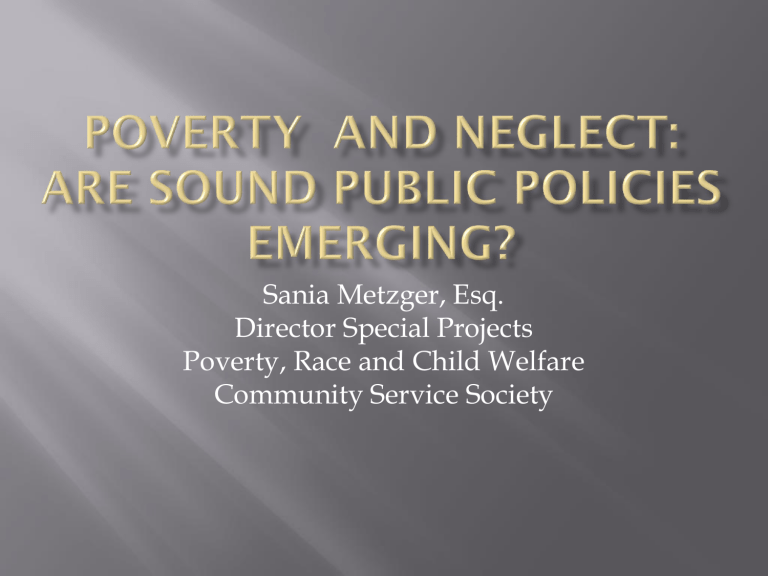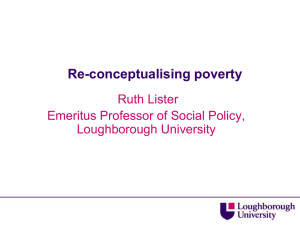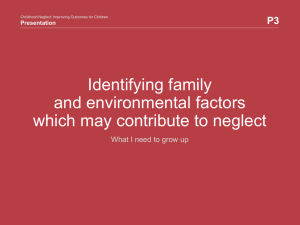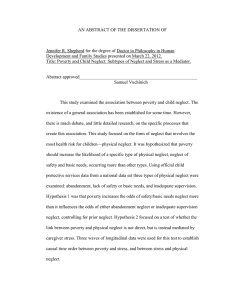Poverty and Neglect - National Abandoned Infants Assistance

Sania Metzger, Esq.
Director Special Projects
Poverty, Race and Child Welfare
Community Service Society
Statement of the problem
Public policy solutions
Thesis:
Differentiating poverty from neglect will curtail unnecessary removals of children from their homes. Differentiating poverty from neglect should drive public policy to, among other things, respectfully include parents in decision making processes and readily provide needed individualized services to low-income families.
Poverty
Structural Racism
Neglect
Almost 11 percent of our nation's children had at least one unemployed parent in 2010, affecting nearly 8 million children.
Between 2005 and 2008, the foreclosure rate for
Blacks and Latinos was roughly 170% of that for Whites and Asian Americans.
By 2009, the percent of families who were asset poor had jumped to 37% percent.
Key findings:Racial disparities in households with young children are dramatic.
In 2007, 32% of white households with young children were income-poor and 14% had no assets.
In comparison, 69% of Latino and 71% of Blacks were income-poor and 40% had no assets.
Racial disparities in child outcomes start early and grow overtime: at nine months children score similarly on standard child development test, but by two years old racial disparities emerge.
New York’s child poverty rate is between 20%-24% along with 18 other states.
Compared to White
Families with children,
Black and Latino families with children are twice as likely to experience economic hardships such as food insecurity.
Black child poverty rates in New York is 30%, and ranges as high as 46% in
Ohio and Michigan.
In New York and the six other states with the largest immigrant population, the child poverty rate ranges from
16% to 34%.
Research consistently shows the strong correlation between poverty and child welfare.
According to the Fourth National Incidence
Study of Maltreatment published in 2010, families with an annual income of $15,000 or less are seven times more likely to experience an incident of child maltreatment than were families with annual incomes above $30,000.
Black and Native American children/youth are three times
more likely to be in foster care than white children/youth; in certain states and counties, Hispanic children are also overrepresented (Hill, 2008).
African American children who are removed from their homes stay in care nine months longer than white children due to “limited access to family support services, limited or inadequate legal representation of birth parents”, as well as
“difficulties in recruiting and retaining permanent homes”
(McRoy, 2008).
Racial disparities in child welfare should be examined in the multisystem context and addressed through multisystemic solutions (McRoy, 2008).
Defining child neglect:
“…knowingly or negligently allowing a child to be deprived of food, clothing, shelter or care”
“ The failure by the caregiver to provide needed, age-appropriate care although financially able to do so or offered financial or other means to do so.”
(The National Child Abuse and Neglect Data System , USDHSS, 2009)
Emotional abuse 0.9%
Physical Abuse 9.8%
Medical neglect 5.3%
Sexual Abuse 3.1%
Neglect 92.2%
Other 25.3%
(The total is greater than 100% because some children experience more than one type of maltreatment.)
Distinguishing Poverty from Neglect
State Poverty Exemptions
The Arkansas code applies a finding of neglect “except when the failure or refusal is caused primarily by the financial inability of the person legally responsible.” Ark. Code Ann. Section 12 -12-
503 (12) (b), 2001
Connecticut enacted a poverty exemption statute in 2011:
A child or youth may be found "neglected" who (A) has been abandoned, (B) is being denied proper care and attention, physically, educationally, emotionally or morally, or (C) is being permitted to live under conditions, circumstances or associations injurious to the well-being of the child or youth, [or (D) has been abused ] except no child or youth may be found neglected solely because the child or youth is impoverished;
‘‘Reconnecting Youth to Prevent Homelessness
Act of 2011’’.
Section 101 Curtailment of involuntary separation of children from their families
This section adds a component that states must have laws and procedures in place to ensure that a child is not placed in foster care solely because the child’s family is homeless, or living in substandard housing.
States would be required to work with the family and state housing authorities to arrange permanent housing for any family that includes a minor child and is either homeless or at risk of becoming homeless.
“We recognized that the biggest correlate to abuse is poverty. The forensic approach [of the traditional investigative model] focuses on compliance and poverty doesn’t respond to that. You can’t just say
‘Don’t be poor’ or, ‘Don’t not have health care’. We realized that families might be better off if we focused on resources rather than on compliance.”
Dave Thompson, the current Child Protection Manager for Minnesota’s Child Safety and
Permanence Division
An alternative to traditional child protection investigation response;
Cases referred to the alternative track do not allege serious or imminent harm;
The policy focuses on assessing the needs of a family rather than on the investigation of an incident to determine fault;
Cases are not “indicated”; family voluntarily accepts services;
The paramount goal of child safety is sought through family engagement and community partnerships.
National Quality Improvement Center on Differential
Response
Institute of Applied Research evaluations of alternative response systems in Missouri, Minnesota and Ohio consistently showed:
- the rate of re-reports declined;
- families were more likely to receive needed concrete services ;
- children were safely provided for at home;
- Differential Response is a cost effective policy;
- family and caseworker satisfaction with the alternative response process.
Multi-disciplinary Parent Legal Representation
Parent Advocacy
Cross –agency Collaboration
Family Team Meetings
Public/Private Partnerships
SANIA METZGER, ESQ.
COMMUNITY SERVICE SOCIETY NEW YORK
DIRECTOR, SPECIAL PROJECTS
POVERTY, RACE AND CHILD WELFARE
105 E. 22 nd STREET
NEW YORK, NY 10010
(212)-614-5468 smetzger@cssny.org








